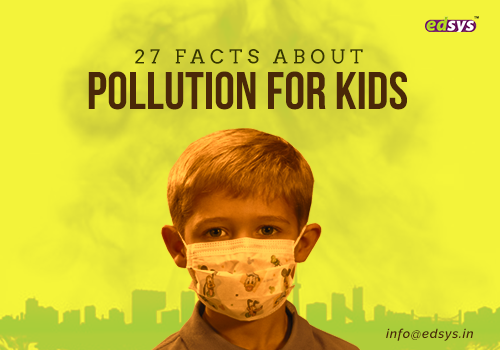Pollution is a condition when harmful and poisonous things are added to the environment. When huge amounts of toxic compounds, elements, smoke, and gases are out into the atmosphere, it causes pollution.
These gases and chemicals are very damaging to social, plant, and animal development. As grown-ups, it is our duty to tell kids about pollution and the necessary steps to curb it from roots.
What is pollution?
Pollution is the entrance of contaminants into the open environment which produces unfriendly change. Pollution can take the form of chemical substances or force, such as sound, heat or light. Pollutants can be both foreign substances and commonly befalling contaminants.
As responsible citizens, we have to make sure that our kids know about pollution, its types and ways to combat it.
Below are facts about pollution for kids in our generation:
1. Kids are more unsafe due to pollution of any kind than grown-ups because at their age their immune system isn’t fully developed.
2. Kids share only10% of the world’s pollution every year but still, they suffer more due to pollution of all kinds.
3. More than 3 million children under the age of 5 years die every year because of environmental circumstances like contamination in water, toxic air, etc.
4. Around 1000 babies die in India each year due to infections caused by the dirty water.
5. According to WHO, 9 out of 10 people of the world’s community exists in regions where air pollution has passed the safe threshold.
6. Air pollution appears 4th in the level of risks pretended to human well-being, after high blood pressure, dietary hazards and smoking.
7. The world’s biggest emitter of carbon dioxide is China, accompanied by the US.
8. Global warming happens when greenhouse gases like carbon dioxide (CO2), methane, carbon dioxide, carbon monoxide, etc.accumulate in the environment and consume sunlight and solar transmission that have jumped off the earth’s cover.
Know More: 21 Motivational Books for High School Students
9. Greenhouse gases are also the prime reason behind the gradual increase in earth’s temperature and are liable for global warming are called Greenhouse gases are also prime sources of air pollution.
10. When smoke and fog are mixed together, they form smog. As it contains small particulate matters and ground-level ozone, it generates serious respiratory disorders, including asthma, breathlessness and lung failure. The term smog was first used in London.
11. Common road-based vehicles like cars, trucks, and buses are big contributors to air pollution because these vehicles use fossil fuels which emit carbon monoxide into the air when combusted.
12. Air pollution can be reduced by amending strict PUC certification rules and also by taking bicycles, electric or hybrid vehicles in daily use.
13. To curb air pollution in Los Angeles, the United States has become the first country to update and take an initiation of the Clean Air Act.
14. Air pollution has the biggest role in worsening breathing problems, increasing respiratory and lung diseases, pulmonary disorders, and Asthma.
15. Till now, air pollution is still uncontrollable because about 3 billion people without a decent house and healthcare cook and heat their houses using free fires and cracked stoves, thus adding more towards pollution and global warming.
16. One of the severe effects of air pollution can be seen as – depletion of the ozone In May 1985, an annual report was submitted stating the affected ozone area over Antarctica. The main reason stated for the depletion was the use of CFCs in cooling and refrigerating equipment.
17. One Chlorine in CFCs (Chlorofluorocarbons) can react with free oxygen in OZONE (O3) and kill up to 100,000 ozone molecules.
18. Depletion of OZONE will adversely impact the environment; UV rays may enter the Earth Atmosphere and might destroy plankton, which is the main source of food in the ocean’s food series.
19. Water is necessary for mortal endurance, but we are falling out of secure drinking water. On Earth, only 2.5% of the available water is fresh water. In rest available water, about 70% of industrial waste and 80% of untreated sewage are dumped.
20. Untreated sewage helps algae to develop in the water which utilizes the oxygen disturbing the total BOD. This disturbance is also another reason for marine life extinction.
Know More: Top 18 Road Safety Rules to Teach your Children
21. Apart from the untreated sewage and industrial waste, 18 billion pounds of plastic is also thrown in oceans every year succumbing marine life to death. It is one of the most serious problems of land and water pollution. Plastic persists on earth for millions of years without degradation.
22. Out of 18 billion pounds of plastic trash, 40% generated is used once for packaging articles and then it is abandoned. It either goes in landfills or contaminates water bodies.
23. About one million plastic drink bottles are marketed every minute throughout the world.12% of plastic is cremated, and 79% is deposited in the landfill, becoming a crucial and no biodegradable source of land pollution.
24. Reduce, Reuse, and Recycle which is also known as Three R’s is the only way to prevent non-biodegradable wastes to reach the soil. If we reduce our waste and decide to reuse them by converting them in new product or item, it will prevent land pollution and soil will maintain to have its fertility. Also, recycling of trash and composting may rescue 85 tons of waste from being discharged into the environment.
25. Water pollution can be efficiently checked by establishing water-efficient toilets, disposing toxic or oily fluid waste after treatment and never dumping synthetic wastes in water bodies.
26. Ganges water in India is a decent example of becoming septic due to the dumping of industrial waste, enshrouded babies and half burnt and unburnt dead bodies.
27. Among different types of pollution, noise pollution is another evil. It occurs due to intense honking, booming music, outcries, and horns. Researches have even shown that sound pollution may induce insomnia, reinforces stress, sound loss, hypertension, and heart disorders. On regular exposure, it can also disrupt people from concentrating on their regular activities.
Final Words:
Kids see this environment as a wonderful place to exist. They admire their house, school, town and the life nearby. As grown-ups, we require to maintain that excellence for forthcoming generations. By giving children enough knowledge to be informed of the problem at hand, we can wish for a safer place to breathe and permit the planet to be better again.



